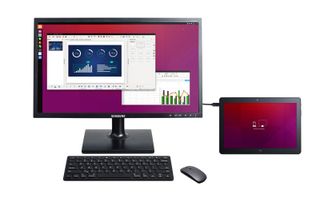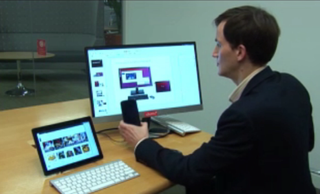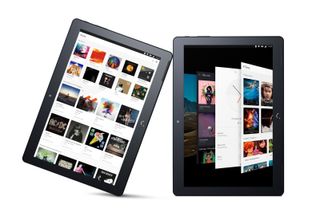Ubuntu Quietly Taking On Microsoft Continuum With 'Convergence' And BQ Aquaris Tablet
Quietly, Canonical has built Ubuntu Core into a true unified platform that runs across all manner of devices and screen sizes, from phones to IoT to desktops and more. If that sounds exactly like what Microsoft is trying to do with Windows 10, that’s because it is, but Canonical has been demonstrating this unification -- “convergence,” the company calls it -- since at least Mobile World Congress 2015.
Microsoft is filling in a huge gap in its platform with Continuum and Windows 10 for mobile (slowly), and with an announcement this week, Ubuntu is adding to its own roster of unified devices with a tablet from BQ called the BQ Aquaris M10 (Ubuntu Edition).

Fully Desktop, Fully Mobile
With respect to BQ, the tablet itself is hardly the story, though. Canonical claimed that “Ubuntu is the only platform that runs both a mobile-based full touch interface and a true PC experience from a single smart device,” and in a brief (and somewhat low-res) webcast demo, the company showed how you can arrive at your desk, connect the tablet to a larger display and wireless mouse and keyboard, and enjoy a dual-screen experience.
The device autodetects that it’s connected to a larger display and kicks into full desktop mode. The demonstrator showed multiple applications running simultaneously in this mode, which is unlike the somewhat hamstrung “multitasking” Microsoft offers with a connected smartphone and Continuum.
On top of that, you also maintain access to the “scopes” on your Ubuntu mobile device, giving you both a desktop and mobile experience, and not "either/or." The underlying code is the same.
Therefore, despite the fact that "convergence" just sounds like marketspeak, it’s actually an entirely accurate way of describing the experience.
Stay on the Cutting Edge
Join the experts who read Tom's Hardware for the inside track on enthusiast PC tech news — and have for over 25 years. We'll send breaking news and in-depth reviews of CPUs, GPUs, AI, maker hardware and more straight to your inbox.

Hey, Was That A Phone?
Although device-wise, today’s announcement centers around the BQ Aquaris M10 tablet, Canonical casually showed a smartphone providing the same experience described above.
He plugged a phone into the display, and suddenly he had desktop control, including mouse and keyboard input. (It appears that he had a wireless keyboard and mouse previously connected.)
No one mentioned which phone it was, although it could be one of the ones from BQ or the more robust Meizu MX4 Ubuntu Edition. That is to say, it’s possibly not an especially high-end device. However, it could also be a yet-to-be-released phone; Canonical mentioned that there will be a smartphone announcement later this year that will offer this same level of convergence.

Performance Questions
All of the above raises the question of performance. It’s one thing to be able to offer true multitasking from a mobile device that’s connected to a mouse and keyboard and is running a second display and automatically scales apps accordingly, but it’s quite another to do it well.
The thing about multitasking is that we tend to push the limits. It’s not uncommon for a tech journalist, for example, to simultaneously run his email, a couple of different web browsers (with way too many tabs open), a chat service, and Photoshop all at once. Considering how often and loudly one’s laptop may protest at such a load, there’s probably no way a tablet like the BQ Aquaris M10 can offer anything competitive.
The demos we saw were impressive, though, even though we didn’t get a chance to see the Canonical folks push the tablet to its limits.
Working With The Competition
Although Canonical is effectively competing against Microsoft here, Canonical CEO Jane Silber said that the company is actually working with Microsoft on cloud and IoT. For example, a tool like Office 365 should work just fine on Ubuntu, and therefore on Ubuntu Core (the underlying platform), and therefore on this tablet (and other future devices).
Further on that front, she said that Canonical is working hard to ensure that users will be able to continue using their favorite services with its platform, such as social media apps and other daily indispensables.
That’s wise, because as we’ve learned from Windows Phone, a robust app ecosystem is a key to success. Silber did not shy away from that issue. She readily admitted that no, there aren’t hundreds of thousands of apps available for Ubuntu (“Yet,” she qualified), but she stated that a growing number of apps and scopes written for smaller form factors are coming to larger form factors. The legacy Ubuntu software catalog is available, and devs can adapt their apps with the Ubuntu SDK.

Talking Hardware
The BQ Aquaris M10 Ubuntu Edition runs on a MediaTek SoC, but Silber said that Ubuntu Core is really SoC-agnostic. Therefore, it should run on ARM or x86 systems, which technically should blow wide open the possibilities for OEM partners. It’s unclear what the future holds in that regard, though; Canonical didn’t allude to any other hardware partners beyond BQ and its tablet for now. (We hope to learn more at Mobile World Congress later this month.)
| BQ Aquaris M10 Ubuntu Edition | |
|---|---|
| Display | 10.1 inch multi-touch, FHD |
| SoC | MediaTek quad-core MT8163A (up to 1.5 GHz) |
| RAM | 2 GB |
| Storage | 16 GB (microSD slot for up to 64 GB more) |
| Camera | -Full HD (1080p) camera -8MP with autofocus and dual flash |
| Ports | Includes micro HDMI |
| Audio | Front-facing speakers |
| Battery | 7280 mAh Li-Po |
| Dimensions | 246 x 171 x 8.2 mm |
| Weight | 470g |
| Availability | March 2016 |
| Price | TBA |
BQ will announce availability and pricing for the Aquaris M10 in March.
Seth Colaner is the News Director for Tom's Hardware. Follow him on Twitter @SethColaner. Follow us on Facebook, Google+, RSS, Twitter and YouTube.
-
delaro 2GB of RAM isn't going to cut it when multitasking, 1 Browser steaming anything is going to take half of that alone and the OS will use a majority of the rest. RAM is dirt cheap why skimp? You need at least 4gb in any device that claims to multitask.Reply -
sykozis Actually, Ubuntu Touch can "multi-task" just fine on 2GB of ram. Linux is nothing like Windows when it comes to memory usage. In fact, Windows Phone can "multi-task" just fine on 512MB of ram. Android is the only mobile OS that requires large pools of ram for "multi-tasking". Of course, proper "multi-tasking" doesn't occur on a mobile device anyway.Reply
Btw...I remember multi-tasking on 8MB of ram.....and I run Ubuntu Touch on a Nexus 4.....
-
Bloob Reply17447045 said:Actually, Ubuntu Touch can "multi-task" just fine on 2GB of ram. Linux is nothing like Windows when it comes to memory usage. In fact, Windows Phone can "multi-task" just fine on 512MB of ram. Android is the only mobile OS that requires large pools of ram for "multi-tasking". Of course, proper "multi-tasking" doesn't occur on a mobile device anyway.
Btw...I remember multi-tasking on 8MB of ram.....and I run Ubuntu Touch on a Nexus 4.....
Pretty sure Ubuntu multi-tasks just fine, much like SailfishOS the apps stays open and execute on the CPU when it is their turn. It's the other platforms where "multi-tasking" means fast switching between tombstoned apps. -
delaro Reply17447045 said:Actually, Ubuntu Touch can "multi-task" just fine on 2GB of ram. Linux is nothing like Windows when it comes to memory usage. In fact, Windows Phone can "multi-task" just fine on 512MB of ram. Android is the only mobile OS that requires large pools of ram for "multi-tasking". Of course, proper "multi-tasking" doesn't occur on a mobile device anyway.
Btw...I remember multi-tasking on 8MB of ram.....and I run Ubuntu Touch on a Nexus 4.....
Okay then.. Chrome or FireFox Running.
1 Tab Youtube
1 Tab Email
1 Tab Facebook
1 Tab a Forum or a SMS program
or
1 High Res Game
1 Tab Youtube or Online Streaming Music Player
1 Tab Voice Chat Program
Blown up on a monitor.
or
1 Tab Streaming Music
1 Tab Browser Game
1 Tab Facebook
1 Tab Skype
It doesn't matter the OS 2 GB of RAM is weak for someone that really Multi Tasks unless your using really low usage Programs. The purpose of blowing your screen up on a Monitor or TV is to do more than 2 tab Email/Facebook. I do use Ubuntu and Windows so I have a clue on how fast ram goes.
RAM Chips are stupidly cheap right now, the cost for a manufacture to go from 2gb to 4gb is less than $3 when your buying in bulk like they do, there is no reason why anything that costs $200 or more should have less than 4gb of RAM right now even if it is a overkill for most users.
-
arenaslicer Just saying...I would love to be able to replace Android with a fully working phone version of Ubuntu.Reply
Fully working is probably too optimistic though huh? -
wussupi83 To help assist with the RAM concern - I run a desktop with 16GB of RAM, a laptop with 4GB and an older netbook with 2GB all on Linux. I never go over 2GB 90% of the time working on websites which includes some photo editing and usually a YouTube video and multiple tabs. I'm not saying you cant - It's not going to replace your gaming rig or VM Host or graphics workstation but it can easily replace your tablet, phone and office laptop. Not saying they can't bloat this up - my DROID is almost always over 2GB but my phones not rooted so Verizon and Samsung crap are probably at fault. Some people argue free RAM is wasted RAM though.Reply -
ZolaIII As the SoC is actually most similar to the MT6735 with quad cluster A53 @ 1.5GHz & T720 MP 2 at 600 MHz i am skeptical about performance in running full blown Ubuntu desktop distro even performance requirements for Linux are lot lesser than for Windows. On the other hand 2GB of RAM simply can't do well enough this day's for anything serious.Reply
With adequate SoC & at least 4GB RAM this would be lovely. -
wussupi83 ReplyAs the SoC is actually most similar to the MT6735 with quad cluster A53 @ 1.5GHz & T720 MP 2 at 600 MHz i am skeptical about performance in running full blown Ubuntu desktop distro even performance requirements for Linux are lot lesser than for Windows. On the other hand 2GB of RAM simply can't do well enough this day's for anything serious.
With adequate SoC & at least 4GB RAM this would be lovely.
If you look at Intel vs ARM benchmarks here (http://www.computingcompendium.com/p/arm-vs-intel-benchmarks.html) you'll see the MT6589 A7 based processor listed in the benchmark outperforms an Intel Atom D525. The MT6589 is A7 based and a slower processor than the MT6735 in this phone. If you look at this benchmark list for Passmark (http://www.cpubenchmark.net/cpu_lookup.php?cpu=Intel+Atom+D525+%40+1.80GHz) you'll see the Atom D525 performs as well as some early Core Duo and low frequency Core 2 Duo's. I personally run Linux Mint on an even older and only single core Intel Atom N455 which performs much worse than the D525 and I can tell you it runs suprisingly well. This tablet's hardware, even though its not even the best of the best, is quite adequate for a normal productivity/Netflix PC. That's a bigger feat than anyone has done before and once they start throwing better processors in it as you stated, and then put it in a phone. It becomes a promising prospect.
edit: corrected phone to tablet. Corrected Atom processor. Added use case. -
ZolaIII @ wussupi83 wouldn't say so. There are a couple of things to reconsider in what you post.Reply
Firstly Geakbench is a joke when it comes to x86 as it uses only elementary SIMD optimizations so actual performance will be different.
Secondary as you use GGC to compile kernel only machines you will be able to use are x86 & if you compile on actual machine you will use you can use mach=native argument for optimizations so it will give some additional bust to it.
Well A53's at 1.5GHz culd actually be marginally just enough to provide a nice Ubuntu experience. Still we all want to see this on better SoC & one that is actually supported by open stack not a MTK bullshit with pore supported ARM MALI.
Most Popular

